Exploration of Translating the Title of Resistance Literature Books (from Persian to English): A Step towards Boosting the Current Models
The title of a book plays a pivotal role in grabbing the attention of the readers. Selecting the right title is one of the most challenging tasks carried out by authors. Authors may spend a lot of time or they may even think for many days on choosing a proper title for their work. In the same line and to the same extent, presenting an appropriate translation for the title is deemed a demanding and time-consuming task on the part of translators. The present paper aims at investigating various techniques being employed in rendering the title of resistance-literature books and presenting strategies which has not yet referred to in already existing models. In fact, the findings of the study can be considered as a step towards boosting the current models dealing with translation of cultural works titles. Yin’s (2009) model was initially used for data analysis. The model is comprised of the following techniques:(A) Transliteration: it refers to the process whereby the translator writes the source-language term by employing the alphabetical letters of the target language. If translators resort merely to this technique while encountering culture-bound-concepts or culture-specific-items, their target audience will not understand the meanings underlying the concepts or terms, and, consequently, translation loss would be unavoidable under such circumstances. (B) Literal translation: translators, by utilizing this technique, attempt to select the closest possible equivalents to the titles of the source-language text. (C) Explication: when the tile of books, mainly literary works, include allusive references which resist being rendered by simply resorting to Transliteration or Literal Translation, the technique of Explication might work perfectly. This technique is almost always accompanied by addition; therefore, the number of words in the target-text title often exceeds that of the source-text title. The additional information sometimes appears within parentheses. (D) Adaptation: in this technique, translators manipulate the cultural references in a way to be simply understood by the target readership. This technique is absolutely target-oriented and the translator prioritizes the target language and the target culture and treats them as being more important than the source language and culture. This technique entails the replacement of, for instance, a proper name (PN) in a source-language title with a target-language PN which brings to the minds of the target readers the same (or, at least, similar) qualities or characterizations of the original PN. (E) Providing a new title: this technique is employed when translators create a new (but related) title merely based on their intuitions or their creative minds. However, since there were a number of techniques unmentioned in Yin’s (2009) model, some other strategies, including Generalization, Particularization, Calque, Omission, Partial shift, Interpretive shift, and Couplet were taken into consideration while analyzing the data. The technique of ‘Providing a new title’ was found to be the only translation technique which had never been employed Furthermore, as the findings revealed, the two techniques of ‘Literal Translation’ (by 63%) and ‘Transliteration’ (23%) were the most frequently used techniques by translators of the titles of resistance-literature books.
- حق عضویت دریافتی صرف حمایت از نشریات عضو و نگهداری، تکمیل و توسعه مگیران میشود.
- پرداخت حق اشتراک و دانلود مقالات اجازه بازنشر آن در سایر رسانههای چاپی و دیجیتال را به کاربر نمیدهد.


